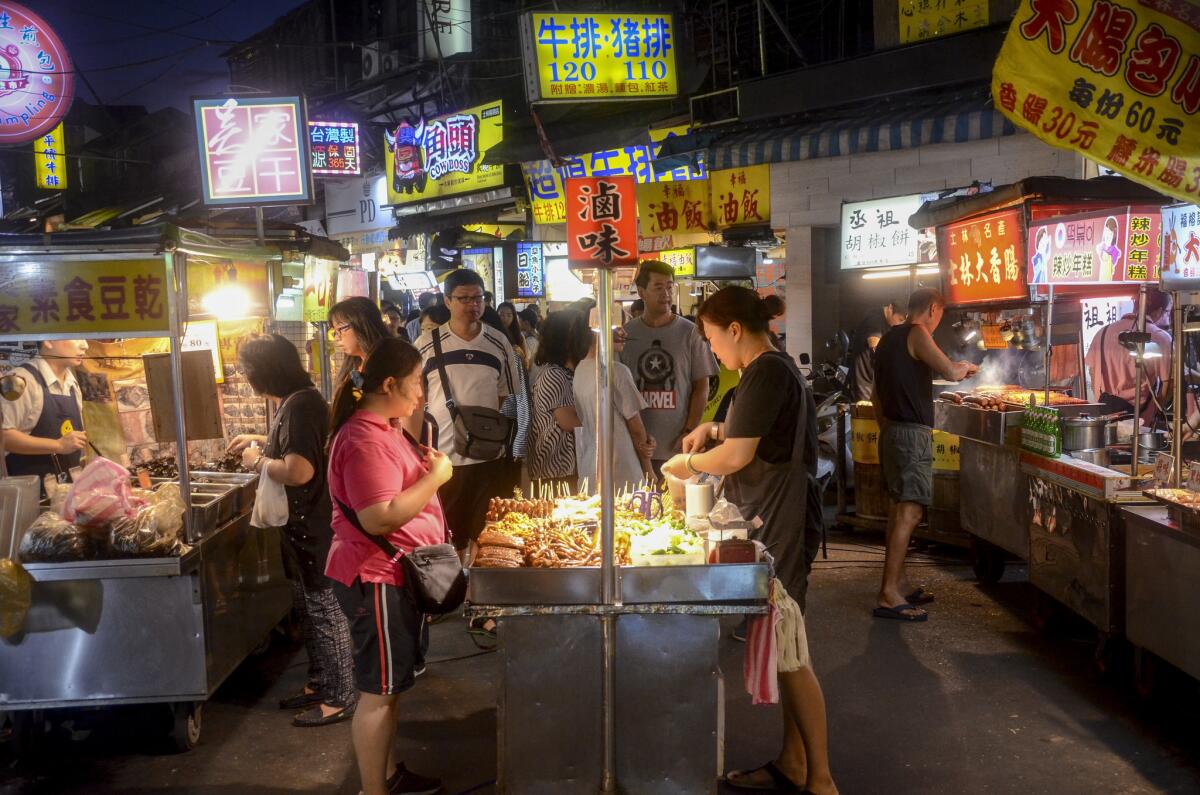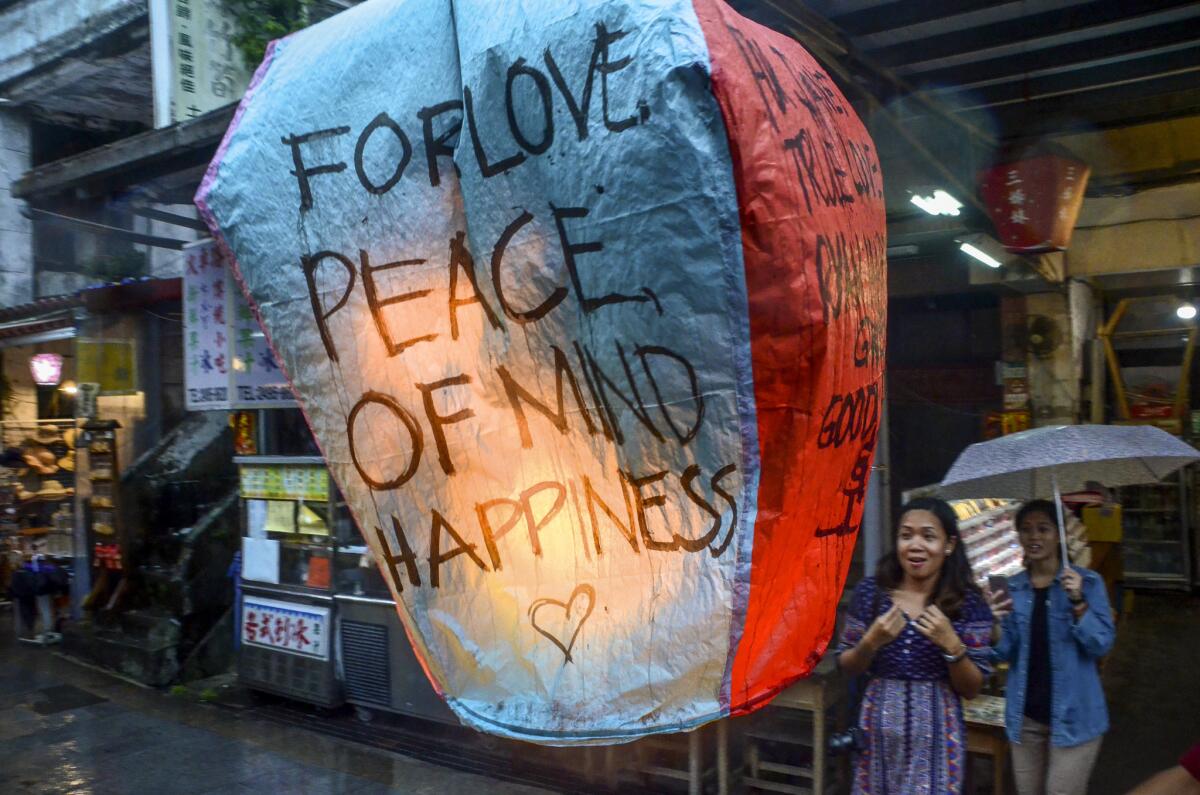Here’s what to see, eat and set on fire in Taipei, capital of Taiwan

On a three-day visit to Taipei, capital of Taiwan, Christopher Reynolds ate his way through a teeming night market, zipped to the observation deck of a 101-story skyscraper, inspected treasures at the National Palace Museum and released a flaming la
- Share via
I stood between two vendors, my belly full of blow-torched beef cubes and sweet potato balls. My neck was wet from rain. The air was thick with scents of fish, fowl and the sizzling, steaming contents of food carts.
My universe was in perfect balance.
Why? Because to my right, one vendor was hawking exotic fruits that looked like festive balloons, and to my left, another was hawking festive balloons that looked like exotic fruits.
Taiwan and its capital, Taipei, are complicated, but I have some strong sensory memories from the four days I spent in the city in the fall.
This island, once known as Formosa, sits about 110 miles off the eastern coast of mainland China. If you’re a visitor from North America, you will eat well and adventurously. You will browse through aged buildings, some of which were bombed by American forces during World War II.
You might feel the ground shake, because Taiwan is positioned along a quake-prone Pacific Rim chain of fault lines. (On Feb. 6, a 6.4-magnitude quake killed nine people in the island’s Hualien area but did no major damage in Taipei.)
You will inspect prized artifacts, many of which were hustled out of China’s Forbidden City 70 years ago. You will see gorgeous coastline. You will be reminded that the Chinese controlled this island from 1683 to 1895, then the Japanese from 1895 until they lost World War II.
And then there’s the awkward history since then.
Once the Japanese were defeated, the Chinese retook Taiwan. But soon it became clear that Mao Zedong and his revolutionaries were about to wrest control of mainland China from its ruler, Chiang Kai-shek.
The embattled Chiang fled to Taiwan with about 2 million allies. He stayed nearly 30 years until his death in 1975.
Even though the mainland Chinese consider Taiwan a renegade province, it started behaving like an independent country, with a galloping high-tech economy and growing international tourism.
China Airlines and Eva Air, both based in Taiwan, fly nonstop between LAX and Taipei. In the first 11 months of 2017, about 518,000 Americans visited Taiwan, up 7.2% from the previous year.
Fortunately for most travelers, you don’t need a political science degree to enjoy the scene around you.
I started my rounds in Taipei at Longshan Temple. Built in 1738 and bombed by American planes during World War II, it has been more or less under renovation through the decades. Its niches and aisles are shared by Buddhists and Taoists, who queue up to honor different deities at different worship stations as incense burns.
Before long, our tour group had made the journey from the 18th century to the 21st. Taipei 101, the city’s signature skyscraper, is, indeed, 101 stories tall and since 2004 has towered over the capital like a great metal-and-glass bamboo stalk.
From the observation deck on the 89th floor (a $20 elevator ride), you notice that the city’s skyline isn’t as sleek as Hong Kong’s, Singapore’s or Shanghai’s. But it has a clean, lively urban core and there’s plenty to eat, including dumplings at the original Din Tai Fung, progenitor of a global restaurant empire that includes several Southern California locations.
Hot topic
There’s a Din Tai Fung in the shopping mall at the base of Taipei 101 too. But don’t let its familiarity keep you from exploring one or more of Taipei’s night markets. They’re a defining feature of the city, generating sights, smells and sounds just as rapidly as Taiwan’s factories generate electronics components.

Every night, couples, friends and families repair to these markets to eat, shop and compete at carnival games.
I had my moment amid the fruit and balloons in Shilin, one of the city’s largest night markets. Even if you’re not hungry, these tightly packed outdoor spaces are great entertainment. You can expect temperatures in the 80s in summer; the 60s in winter.
And rain. Even in its driest months, Taiwan gets 10 to 15 days of precipitation, and typhoon season runs June through October. If you’re Taiwanese, a little rain isn’t worth mentioning.
But Chiang Kai-shek — that’s a hot topic. One morning I joined a group at the Chiang Kai-shek Memorial, a vast commemorative space that was built in the five years after Chiang’s death. There’s a concert hall, a theater building and a public plaza.
Our first stop was the memorial’s main chamber, which was laid out a bit like the Lincoln Memorial in Washington — a tall statue of a seated Chiang flanked by flags and guarded by live soldiers in silvery helmets.
Guides, speaking various languages in hushed tones, escorted visitors through.
But by the time you read this, things may be very different in that room. In early December, Taiwan’s parliament passed a law that calls for erasing Chiang’s name and likeness from landmarks across the island, an acknowledgment of the killings and oppression that came with his arrival 70 years ago.
The Ministry of Culture has pledged to turn the memorial into a public space “facing history, recognizing agony and respecting human rights.” Whatever goes into that space, it will be worth a visitor’s attention.
So is the National Palace Museum. This is where you can browse among some of the 600,000-plus artworks and artifacts — centuries of cultural wealth — that Chiang’s people had spirited away from mainland China. My favorite work was “The Vast Expanse of the Yellow River,” an epic landscape that, as it turned out, was painted in the 1980s by artist Lu Fo-ting. Incredible harmony of detail.
But that’s not where the biggest crowd gathered. The Mona Lisa of the museum is a 7-inch-tall chunk of jade that an unknown 19th century sculptor carved into a bok choy cabbage being nibbled by a locust and katydid.
Thanks to the artist’s clever treatment of his materials, the stone’s green and white hues and other imperfections mimic the color and texture of the leaves. Precious materials, homely subject, minute detail.
Lantern launching

On my last full day in Taipei, I got a close look at another artifact of local culture — and this time it came with some hands-on experience.
This was in Pingxi, a former coal-mining town about an hour from central Taipei and now better known for lantern launching.
The community hosts an annual festival (March 2 this year) that concludes with the release of thousands of lanterns, each carrying its flame into the night. If you’ve seen the Disney animated feature “Tangled,” you can picture the spectacle.
But what if a visitor shows up and there’s no festival?
Not to worry. Pingxi’s railroad tracks are lined with workshops whose proprietors will help you build a lantern with thin paper and glue, then invite you to scrawl your hopes and dreams on its four sides.
The cost is often less than $10, but if you sign up for one of the day trips that take visitors by bus to Pingxi and Jiufen (a former gold-mining town), the price of your lantern may be part of the package.
Once your lantern is made, you wait for a pause between passing trains and recurring rains. Then as the shopkeeper lights your little fire, you hop out onto the tracks and launch your lantern.
The idea is that you will watch it drift over the rooftops, whereupon either rain or the damp landscape will douse the flames. The reality is that sometimes lanterns crash right away.
“It is only a matter of time before there is a major fire,” said a writer on Lonely Planet’s website.
As I watched, a woman from India saw her dreams collapse in flames at her feet. She maintained an impressive poker face as the vendor hastily put out the fire and pulled out a replacement lantern for a do-over.
Then it was my turn.
The lantern drifted straight up, a red-yellow dot headed into a gray sky. Part of my brain understood this to be a tourist exercise. Another part interrupted to ask, “You’re doing what with my hopes and dreams?”
Then the lantern lurched left, skirted a building and swooped right, far too low. In the crowd along the tracks, somebody screamed. Then, just when it seemed a goner for sure, my lantern levitated and cleared the rooftops.
If you go
THE BEST WAY TO TAIPEI, TAIWAN
From LAX, China Airlines and EVA offer nonstop service to Taipei, and JAL, United and Cathay Pacific offer connecting service (change of planes). Restricted round-trip airfares from $765, including taxes and fees.
WHERE TO STAY
Hotel Quote Taipei, 333 Nanjing East Road, Section 3, Songshan District, Taipei. Centrally located boutique hotel with a pleasant guests’ lounge on second floor. Doubles from about $160.
WHERE TO EAT
#21 Goose & Seafood, 21 Jinzou St., Zhongshan District, Taipei. Known for its goose dishes. About 10 tables, loud with conversation. Menus in Mandarin and English. Most dishes $5-$15.
Puppet Master, 13 Shuqi Road, Jiufen, Ruifang District, New Taipei City. Good fish. Besides the views out the many windows, its interiors are full of old movie posters.
Spot Café Lumiere, No. 18, Sec. 2, Zhongshan N. Road, Zhongshan District; Taipei. Cinema-adjacent snacks beer and wine, up to $8
TO LEARN MORE
Several companies offer Taipei-based day trips to Pingxi, Jiufen, Sun Moon Lake and other popular spots for $75-$125 per person. I used MyTaiwanTour .
ALSO:
Thrilling hikes along with face-sized spiders in Taiwan’s version of Yosemite National Park
This was the Vietnam I dreamed of
Follow Reynolds on Twitter: @MrCSReynolds
Sign up for The Wild
We’ll help you find the best places to hike, bike and run, as well as the perfect silent spots for meditation and yoga.
You may occasionally receive promotional content from the Los Angeles Times.




